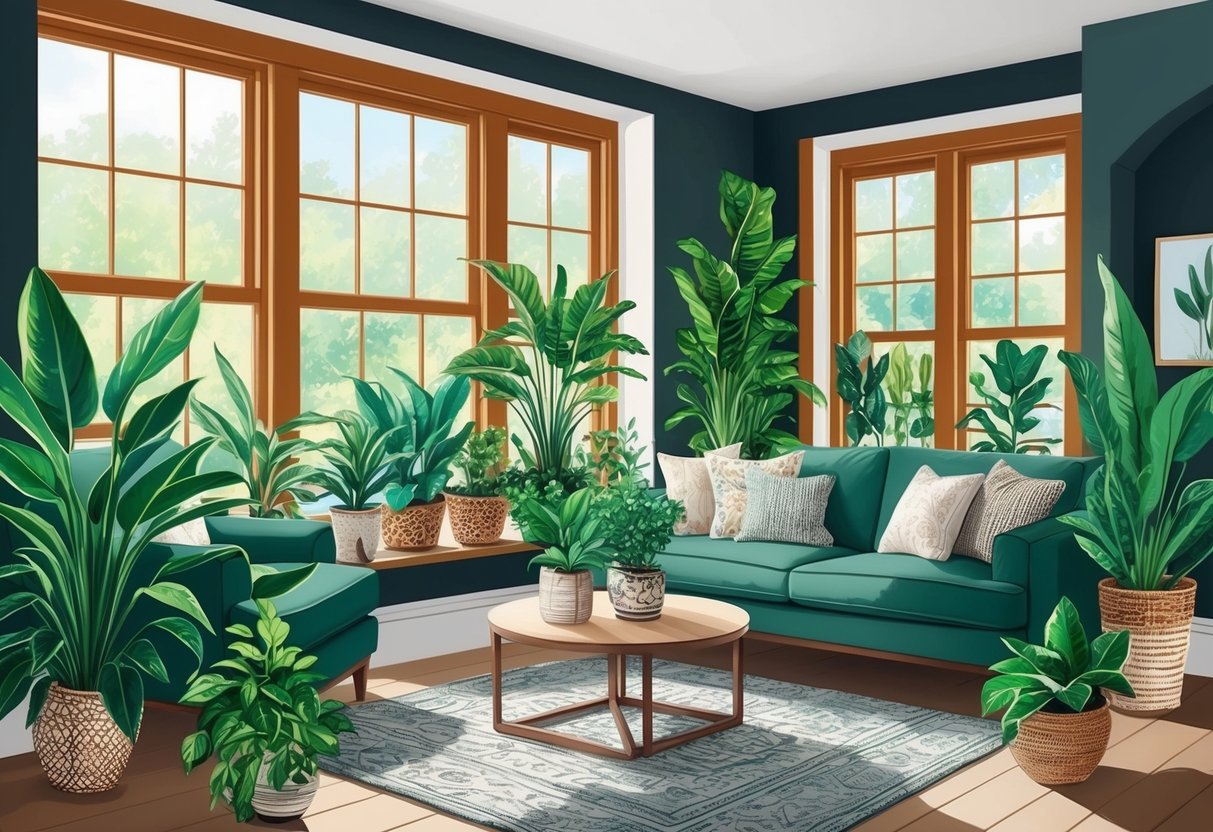
ZZ Plant
The ZZ plant (Zamioculcas zamiifolia) features glossy, dark green leaves that reflect light and instantly make a room feel fresher. Tolerant of shade and infrequent waterings, ZZ plants thrive in neglected spaces and remain healthy even under fluorescent lights.
This houseplant’s rhizomes store water, allowing it to survive drought-like conditions and making it one of the easiest shade-loving plants for busy households. Wipe the leaves occasionally to maintain their shine.
ZZ plants prefer to be left alone and rarely struggle with pests or disease. Pet owners should note that all parts are considered toxic if ingested.
Peace Lily
The peace lily (Spathiphyllum) produces elegant white blooms even when grown in moderate to low light. Its glossy, pointed leaves look lush in dark corners, while the plant also helps improve indoor air quality by filtering pollutants.
Peace lilies prefer consistently moist soil but not soggy conditions. They benefit from occasional misting to boost humidity.
Yellow leaves often signal overwatering, so it’s best to water when the top inch of soil feels dry. Peace lilies are mildly toxic to pets and should be placed out of reach in homes with cats or dogs.
For more suggestions, check the best houseplants for dark and shady rooms.
Decorative Ferns and Lush Foliage Plants
Plants with lush foliage are a top choice for dark corners because their broad leaves are highly effective at photosynthesis in low-light conditions. Popular options like ferns, cast iron plants, and parlor palms can make any indoor setting livelier and more inviting.
Boston Fern
The Boston fern (Nephrolepis exaltata) is well-known for its dense, feathery fronds and arching green leaves. It thrives in filtered or indirect light and consistently moist soil.
High humidity is key to keeping this fern healthy indoors. Bathrooms with moderate warmth and some natural light make great homes for this plant.
Regular misting can help the fronds maintain their lush green appearance. Proper care also includes keeping the plant away from heating vents or cold drafts, which can cause the leaves to brown or drop.
The Boston fern is a classic choice for those wanting to fill shady spaces with greenery, as discussed in indoor plant guides like BHG‘s low-light plant list.
Cast Iron Plant
The cast iron plant (Aspidistra elatior) is famous for its resilience and ability to thrive in low-light settings that would challenge most houseplants. Its dark green, elongated leaves create a dramatic effect in rooms with minimal sunlight.
This plant can tolerate neglect, irregular watering, and varying humidity levels. Key care tips include planting in well-draining soil and watering when the top inch is dry.
Fertilize sparingly, as the cast iron plant grows slowly and does not need frequent feeding. It is ideal for corners where other foliage plants might struggle, holding a reputation for near-indestructible performance among shade-loving houseplants.
Parlor Palm
The parlor palm (Chamaedorea elegans) is a compact palm that adds a tropical look with its graceful, arching fronds. It is well-suited to low-light rooms and adapts well to indoor humidity conditions, making it popular in offices and homes alike.
Parlor palms prefer evenly moist but not soggy soil. They can handle occasional dryness and do not require special attention beyond basic watering and occasional fertilizing.
Their gentle, airy foliage helps brighten dark corners without overwhelming small spaces. For those looking for a palm-like plant that endures less-than-ideal light, the parlor palm is a dependable choice as mentioned in shade-loving indoor plant collections.
Unique Shade-Loving Vines and Trailing Varieties
Vining and trailing plants can add movement and lush coverage to indoor spaces, especially in rooms that don’t get much direct sunlight. Many of these shade-loving varieties are prized for their adaptability to lower light and their ability to cascade from shelves or climb supports.
Philodendron
Philodendron has earned a strong following among fans of indoor shade-loving plants. It thrives in low light, needing only filtered sunlight or indirect light.
With its heart-shaped leaves and versatile growth habit, philodendron can be grown as a trailing vine or trained to climb a moss pole or trellis. This plant prefers soil that drains well and remains lightly moist, making it well-suited for typical indoor conditions.
It is relatively low-maintenance, requiring only occasional pruning to remove leggy stems. Clip the stems just below a node to encourage bushier growth.
Philodendron hederaceum and ‘Brasil’ are especially popular for their vibrant green foliage with variegated patterns. All philodendrons should be kept away from pets as their leaves can be toxic if ingested.
Key features of philodendron:
- Adapts to a range of light levels
- Thrives as a trailing or climbing houseplant
- Notable for air-purifying qualities
Monstera
Monstera, particularly the popular Monstera deliciosa and Monstera adansonii, is a standout among indoor vines. Its fenestrated (holey) leaves add a bold architectural look to shaded corners.
Monsteras prefer bright, indirect light but also tolerate medium and low-light rooms. This makes them suitable as shade-loving houseplants.
Monstera vines naturally climb using aerial roots. They can be grown up moss poles or allowed to trail.
They prefer a well-draining potting mix and watering once the top inch of soil has dried. Overwatering should be avoided to prevent root rot.
New leaves typically appear every few weeks in active growth periods. Regular support or guiding of the vines helps maintain their attractive shape.